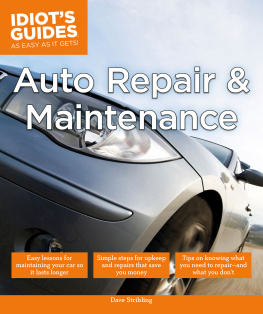
CarTech
CarTech, Inc.
39966 Grand Avenue
North Branch, MN 55056
Phone: 651-277-1200 or 800-551-4754
Fax: 651-277-1203
www.cartechbooks.com
2014 by Mike Mavrigian
All rights reserved. No part of this publication may be reproduced or utilized in any form or by any means, electronic or mechanical, including photocopying, recording, or by any information storage and retrieval system, without prior permission from the Publisher. All text, photographs, and artwork are the property of the Author unless otherwise noted or credited.
The information in this work is true and complete to the best of our knowledge. However, all information is presented without any guarantee on the part of the Author or Publisher, who also disclaim any liability incurred in connection with the use of the information and any implied warranties of merchantability or fitness for a particular purpose. Readers are responsible for taking suitable and appropriate safety measures when performing any of the operations or activities described in this work.
All trademarks, trade names, model names and numbers, and other product designations referred to herein are the property of their respective owners and are used solely for identification purposes. This work is a publication of CarTech, Inc., and has not been licensed, approved, sponsored, or endorsed by any other person or entity. The Publisher is not associated with any product, service, or vendor mentioned in this book, and does not endorse the products or services of any vendor mentioned in this book.
Edit by Paul Johnson
Layout by Monica Seiberlich
ISBN 978-1-61325-207-9
Item No. SA334
Title Page: In order to avoid appearance issues and to increase system longevity, either ceramic-coated system components or using a 100-percent stainless steel system is required. The only thing to consider is that a ceramic coating protects the exterior of the pipes, but long-term corrosion on the inside of the pipes can take place. A high-grade stainless steel pipe provides anti-corrosion protection on both inside and outside walls.
Back Cover Photos
Top Left: Top-quality exhaust pipe manufacturers take the time to develop locating jigs for the placement of hanger rods to precisely match OEM fit. While cheap offshore pipes may or may not fit properly, leading U.S. exhaust pipe makers strive to produce pipes that exactly match the OEM designs.
Top Right: Merge crossovers are precision cut for flow, then carefully TIG welded to seal all seams. This results in a smooth flow transition with minimal exhaust flow turbulence, in contrast to a straight balance pipe thats welded at 90 degrees to the main pipes.
Middle Left: When a slip joint is fabricated, the end needs to be expanded. In this photo, a 3-inch pipes end has been expanded to allow a slip-fit to a muffler that features a 3-inch entry pipe stub.
Middle Right: A timesaving approach to header prototype design is to tack weld and assemble a series of tube sections in a specific vehicle, rather than use the time-consuming task of making numerous test bends.
Bottom Left: Once the primary tubes for a specific application have been bent to shape and cut to length, the individual tubes are assembled in a welding jig that holds the tubes in place at the flange and grouped to achieve the proper arrangement.
Bottom Right: This bank was mocked up using plastic blocks. Shown here is one metal primary tube that was replicated using the modeling blocks, clamped together, and tack welded. The collector is attached, keeping tubes in the correct location. (Photo Courtesy Icengineworks)
CONTENTS


During the research for this book, a select number of exhaust industry experts were kind enough to provide guidance. My thanks to the following for their assistance:
George Rumore, Stainless Works; Jim Robinson, Ultimate Headers; Brian Carruth, Trick Flow Specialties; Jim Laughlin, Spiral Turbo Exhaust; Dan Lopez, Corsa Performance Exhaust; Victor Franco, Icengineworks; Vince Roman, Burns Stainless; Chase Knight, Crane Cams; Scott Gressman, Gressman Powersports; Tony Lombardi, Ross Racing Engines; Bob Fall, Fall Automotive Machine; David Borla, Borla; Don Miller, Addison-McKee; Andy Shapiro, Flowmaster; Eric at Classic Chambered Exhaust; Dan Swain, Swain Tech Coatings; Rob Griffin, Cerakote Ceramic Coatings; Christy Johnson, Cherry Bomb; Henry Hippert, Eastern Catalytic; Bill Tichenor, Holley Performance; Cheryl Harrik, Jet Hot Performance Coatings; and Custom Exhaust, Wooster, Ohio.

The exhaust system is a vital component of engine package, but all too often exhaust system design, components, and function are an afterthought. Owners arbitrarily bolt on a header, resonator, catalytic converter, and muffler combination that may or may not be suited to the chassis or properly tuned to deliver the best performance. When building a high-performance engine application, you need to consider the function and operation as an integrated system. In particular, the carb, intake, and cam directly dictate how much fuel is put into the engine. Moreover, the air/fuel mixture that is put into the engine must be evacuated from the engine. The engine needs to evacuate exhaust gas from the combustion chamber efficiently and quickly. However, it also effectively scavenges and returns unburned to the combustion chamber during the scavenging process. An exhaust system thats ill suited to the engine degrades performance pure and simple.
The book is your hands-on guide to achieve the ultimate in exhaust performance. Its not a guide that provides advanced physics and flow dynamics to explain theory and function of exhaust. Instead, it provides practical advice and easy-to-understand math so you gather all the right components for your engine. It allows you to understand your engines exhaust system and select exhaust system components, with regard to function and engine performance as well as appearance. The discussions include exhaust header design and sizing, exhaust pipe sizing, exhaust pipe crossovers, bending, flanges, clamping and hanging, muffler designs, catalytic converter design, troubleshooting and break-in, exhaust component materials and specialty coatings, exhaust system math, exhaust design and sizing for turbocharging and supercharging, cylinder head exhaust valves and port design, the intake system that affects exhaust output, camshaft design that affects the exhaust pulse, and more.
Next page





